Vegan Macro Cheat Sheet
This vegan macro cheat sheet covers all the best plant-based sources of carbohydrates, proteins and fats. This list may be useful for anyone following a flexible dieting approach to eating, trying to increase their protein intake or trying to achieve a more balanced approach to a vegan diet.
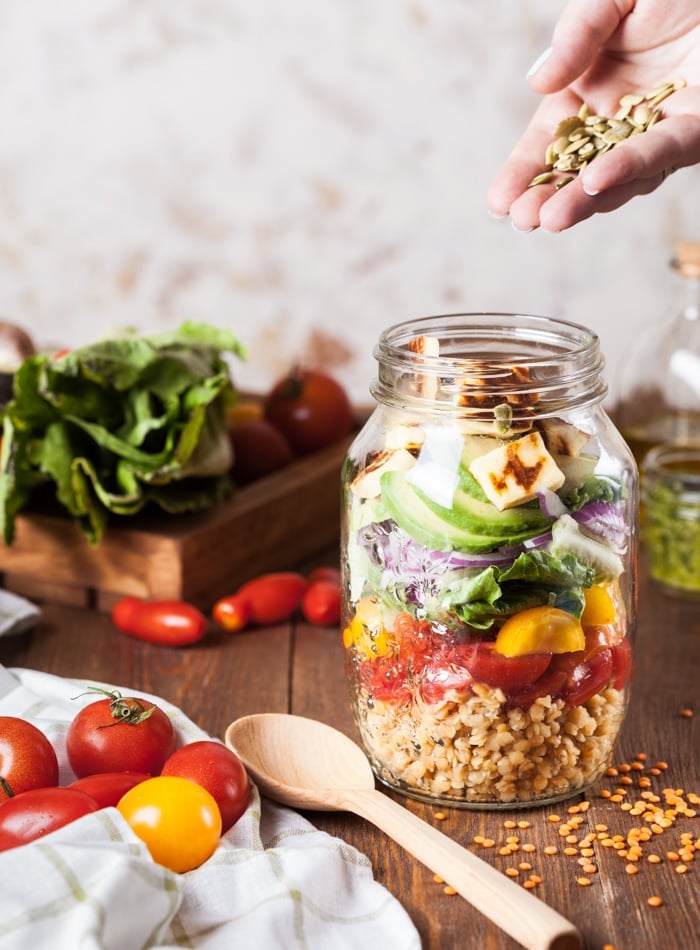
What are Macros?
Macros is an abbreviated term for macronutrients. Macronutrients are essential nutrients we need large amounts of to function, as opposed to micronutrients which we only need in small amounts.
The three macronutrients we require are carbohydrates, fats and protein and we get these through the foods we eat.
What is Flexible Dieting?
Flexible dieting, or tracking macros, is a more specific way of counting calories. It involves tracking the number of carbs, fat and protein you eat.
To determine your macros, your TDEE is calculated (total daily energy expenditure, or how many calories you need) and then that is broken down further into grams of fat, carb and protein.
Once you have that number, your macros can be adjusted towards a calorie surplus (for muscle gain), calorie deficit (for fat loss) or eating the calories needed to maintain your weight. One gram of protein of carbohydrate contains 4 calories and one gram of fat contains 9.
Eating specific macros for your goals and genetics may help you reach your goals faster, maintain lean muscle mass and feel better overall than if you just counted calories.
Why track macros?
Tracking macros is often used in bodybuilding to achieve the low body fat needed for a competition or build muscle, but it’s also common in sports such as weightlifting and fighting where weight classes are involved, and in CrossFit for athletic performance.
Flexible dieting is a method of eating used to improve nutritional intake so you can train hard, recover well and perform at your best. It’s also used to achieve a desired body composition or manage body weight.
I don’t normally suggest this to anyone who does not have athletic performance or competition goals. Tracking your food intake is not necessary in order to eat healthily and feel good.
There are other simple habits you can use to improve how you eat and counting calories is not one of them.
Weighing and Tracking Your Food
Flexible dieting involves weighing your food and entering it into an app such as My Fitness Pal. For most people, this just isn’t necessary. General healthy eating and weight management can be obtained without tracking what you eat.
That being said, tracking your macronutrient intake can help you become more aware of how certain foods affect you and can be a helpful tool to use temporarily to understand portion sizes and how to build more balanced meals.
Making it Sustainable
Maintaining perspective and a healthy relationship with food is hugely important if you plan to try flexible dieting. As much as people say it’s not a diet, it is still a diet, however, it can be done in an enjoyable and sustainable way.
There are no “good” and “bad” foods in this approach to eating and nothing is off limits.
I use this approach in my diet but I am not super strict. I enjoy treats, and untracked meals, I eat out occasionally and I do not track food on vacations.
I know what healthy eating looks like and I don’t need an app to tell me how much to eat every day. I’m not a professional athlete or trying to make a weight class for competition but I do have athletic goals and by watching my food intake, I can make the most of my time in the gym.
Consistency is far more important than perfection and if you want to make this a sustainable way to eat, having a flexible approach to this lifestyle is essential. If you’re new to eating well, developing general healthy eating habits is far more powerful than tracking macros.
Pyramid of Nutritional Importance
Remember that energy balance (calories in vs. calories out) will still be the biggest determinant of results, meaning being over or under on one of your macros is not a big deal. You’re better off staying within your calorie goals regardless of if you’re over or under on one particular nutrient.
This allows for some flexibility and a focus on food quality. For example, I do not recommend consuming spoonfuls of oil to hit your fat goals. You’re better off adding some extra veggies, beans, nuts or a whole-grain snack to make up the calories.
Focus on energy balance, or the bottom of the nutrition pyramid, first. After you’ve nailed that, move on to macronutrient intake, then micronutrients and finally nutrient timing and supplements. Hitting your daily caloric needs takes precedent over hitting your protein, fat or carb target.
Food Quality Matters
I believe a focus on food quality is important even if you’re tracking macros. Rather than thinking about “what you can fit in,” think about what’s in the food you’re eating. How is it going to benefit you?
Sometimes we benefit emotionally and mentally from including treats and that’s a totally normal part of a healthy diet, but for the most part, a focus on high-quality food sources is essential. Micronutrients matter too.
Just because something is lower in fat or carbs does not mean it’s better for you. By focusing on the quality of your food, you’ll sleep better, have more energy and support a healthy gut and hormones and be healthier in the long term.
How to Use this Cheat Sheet
This macro cheat sheet covers vegan sources of carbohydrates, fats and protein. In the plant kingdom, however, there is often an overlap between macronutrients. Sources of protein tend to come with either carbohydrates, such as in beans, or fat, such as in nuts and soy.
We’ll start by covering carbohydrates, then delve into fats and finally protein + carb sources, protein + fat sources and some helpful packaged foods.
Even if you don’t track macros, you can use this list to help you build a more balanced vegan diet.
A good place to start is filling your plate with anywhere from 50-60% carbohydrates with a focus on vegetables, then adding roughly equal amounts of protein and fats. From there, adjust to suit your own nutritional needs and how various foods make you feel.
Sources of Carbohydrates
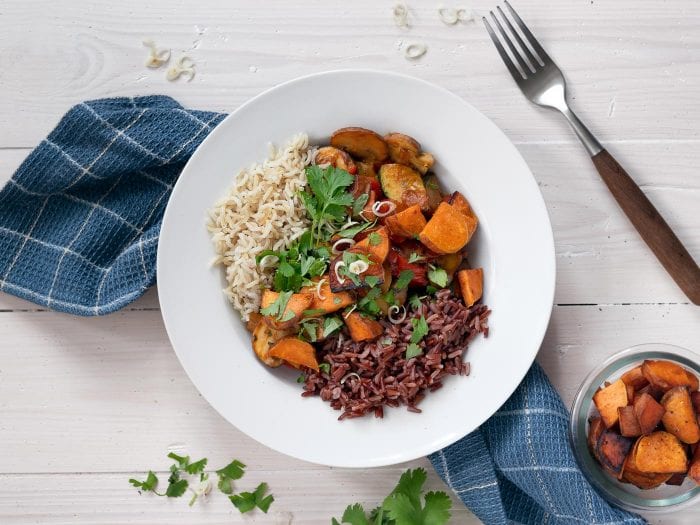
We get carbohydrates from fruits, whole grains, and vegetables, as well as in smaller amounts from all plant foods.
Types of carbohydrates vary from starchy, higher carbohydrate foods such as grains and potatoes, to non-starchy, low-glycemic foods such as green vegetables.
Depending on your goals, I would recommend using starchy carbohydrates such as oats and sweet potatoes to fuel for and recover from your workouts and then filling the rest of your carbohydrate needs with non-starchy vegetables.
Refined vs Unrefined Complex Carbs
Carbs also differ from refined carbohydrates to unrefined, complex carbohydrates. If you’re unsure of what refined carbohydrates are think packaged and frozen desserts, conventional store-bought bread, processed cookies, cakes, muffins and pastries, processed granola bars, pasta and sugary breakfast cereals, frozen pizzas and basically anything else that can be found in the packaged snack aisle.
Processed foods with high amounts of refined sugar include soda, juice, condiments like ketchup and BBQ sauce, pasta sauces, frozen meals, white sugar and processed food with corn syrup or high-fructose corn syrup listed.
These types of foods should not be the basis of your carbohydrate intake. Instead focus on whole grains, fruits and vegetables.
Also, consider fiber when choosing carbohydrates. Learn more about the best sources of fiber and why it’s important here.
Top Picks for Healthy Carbohydrates
- Root vegetables. I love carrots and beets, they’re both nutrient-rich and contain a modest amount of carbohydrates. I use them often in smoothies, salads, oatmeal and buddha bowls. Include roasted, steamed or grated beet and carrot in your weekly meal prep so you’ve always got some ready to throw into meals.
- Squashes. I love butternut squash, acorn squash, pumpkin and kabocha squash. Squash is nutrient-rich and you can enjoy a large serving for a relatively low amount of carbohydrates. Squash is a staple in my diet for both meals and snacks.
- Sweet potato. A medium sweet potato has about 24 grams of complex carbohydrates with a trivial amount of fat and protein and they’re wonderfully nutrient-rich. Sweet potato is very high in vitamin A and a good source of vitamin C, B vitamins, antioxidants and potassium.
- Potatoes. Potato is a filling, nutritious starchy carb source. I love making baked oil-free fries or a baked potato topped with tahini or ranch dressing.
- Brown rice. 1 cup of cooked brown rice contains 44 grams of carbs with 5 grams of protein and less than 2 grams of fat.
- Quinoa. 1 cup of cooked quinoa contains 40 grams of carbs with 8 grams of protein and 4 grams of fat.
- Rolled oats. 1/2 cup of dry rolled oats contains 33 grams of carbs with over 6 grams of protein and just 3 grams of fat. I love oats before a workout.
- Blueberries. Blueberries are antioxidant-rich and have anti-inflammatory and cancer-fighting properties. 1 cup of blueberries has 20 grams of carbohydrates with essentially no fat or protein making them a wonderful high-volume food to enjoy as a sweet treat or add to oatmeal and smoothies.
- Apples. A medium apple has about 22 grams of carbs with essentially no protein and fat. Crunchy and sweet, they’re a great way to satisfy your sweet tooth. Enjoy them with almond butter for some healthy fats.
- Banana. You can’t beat bananas for a quick boost in natural energy. Bananas are like a natural power bar and make a convenient way to fuel on the go. One medium banana contains 25 grams of carbs, not fat and a trace amount of protein.
- Strawberries. Strawberries are my favourite fruit for enjoying a sweet, high-fibre, nutrient-rich treat. 1 cup of strawberries contains 11 grams of carbohydrates and little to no fat and protein.
- Zucchini. Zucchini is my favourite way to bulk up meals without extra carbs. I love adding them to smoothies, oatmeal, and stir-fry and making zucchini noodles. 1 cup of chopped zucchini has just 4 grams of carbs with 1.5 grams of protein and no fat.
- Broccoli. Broccoli is just so nutritious you can’t pass it up as a healthy source of carbs. Include it in your diet frequently. 1 cup of broccoli has just 6 grams of carbs with 2.5 grams of protein and no fat.
Starchy Carbohydrates
Starchy carbohydrates are higher in carbs than non-starchy carb sources such as green veggies. Use these foods around your workout to fuel up and recover.
I recommend sticking to low-GI carbohydrates sources to help keep your blood sugar levels more stable by preventing spikes in insulin. That being said, easily digestible, high-GI carbs can be useful for quick energy.
The foods in this section are all essentially fat-free sources of carbohydrates. Whole grains contain some protein but otherwise, this food group is all carbohydrates.
Fruits (Lower Carb)
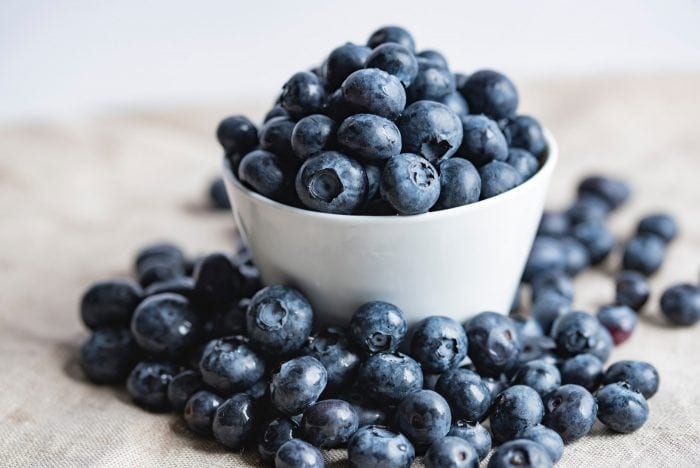
These fruits are low-GI carbohydrates and contain little to no fat and protein. Berries are particularly high in antioxidants, and have anti-inflammatory properties, making them an excellent addition to any diet.
These fruits are high-volume for the number of carbohydrates they contain so they’re great for filling up and enjoying a sweet, low-sugar treat.
- strawberries
- blackberries
- blueberries
- raspberries
- oranges
- peach
- watermelon
- apple
- grapefruit
- pear
- plum
- canteloupe
Fruits (Higher Carb)
These fruits are higher in natural sugars and more dense than the fruit we discussed above. Use these fruits as a natural source of quick energy such as before, during or after a workout. These fruits are moderate-GI carbohydrates with little to no fat or protein.
- banana
- mango
- papaya
- pineapple
- dates
- plantain
- dried fruits (eat in moderation, only if needed) such as raisins, cranberries, goji berries and mulberries
Root Vegetables and Squashes
Root vegetables and squashes are wonderfully nutritious foods and an excellent source of unrefined carbohydrates. These vegetables are a starchy source of carbohydrates.
These foods are low in sugar with moderate carbohydrates, a good source of fiber and contain little to no fat and protein.
- kabocha squash
- butternut squash
- acorn squash
- pumpkin
- sweet potato, any variety
- yam
- potato
- carrots
- parsnips
- turnip
- rutabaga
Whole Grains (Higher Carb)
Whole grains are rich in iron, folate, B vitamins and fiber. Whole grains are a starchy, low-GI source of carbohydrates that contain little to no fat and a small amount of protein.
These are excellent foods for active individuals to enjoy to fuel their lifestyle.
- amaranth
- barley
- brown rice
- buckwheat
- bulgur
- corn
- einkorn
- farro
- kamut
- millet
- teff
- fonio
- quinoa
- oats
- rye
- spelt
- wild rice
- popcorn – makes a great high-volume snack!
Bread
- whole grain bread, rolls, buns and tortillas
- corn tortillas
Pasta
- quinoa pasta
- brown rice pasta
- whole wheat pasta
Flour
- spelt flour
- whole wheat flour
- rye flour
- buckwheat flour
- brown rice flour
- chickpea flour (my favourite – try my chickpea flour pancakes)
- quinoa flour
Legumes
I’m including legumes in both the starchy carbohydrate and protein sections. Legumes such as beans and lentils are a good source of complex carbohydrates but also contain protein. They are inexpensive, nutrient-rich, a good source of iron, low in fat and high in fiber.
- beans, any variety (chickpeas, black beans, adzuki beans, mung beans, pinto beans, fava beans, white kidney beans, broad beans, black-eyed peas etc.)
- lentils, any variety (red lentils, green lentils, French lentils, black lentils)
Sweeteners
- maple syrup
- coconut sugar
- agave syrup
- molasses
Refined Carbohydrates
These foods are easily digestible (low-fiber) and may be useful at certain times for a quick source of energy.
- couscous
- white bread
- white rice
- regular wheat pasta
Non-Starchy Carbohydrates

Non-starchy sources of carbohydrates are nutrient-dense, low-glycemic foods that should make up a large part of your diet.
These foods are high-volume, making them a great way to fill up without overdoing it on carbs or calories. Vary your choices weekly and try to eat as many different colours as possible to increase your micronutrient and antioxidant intake.
These foods are low in carbohydrates and some, such as broccoli, mushrooms and kale, have a small amount of protein. They contain next to no fat, if any.
- broccoli
- cucumber
- celery
- eggplant
- kale
- spinach
- swiss chard
- watercress
- lettuce of any variety
- collard greens
- sprouts
- onions, any variety
- mushroom
- bell peppers
- jalapeno
- artichokes
- bamboo shoots
- cabbage
- brussel sprouts
- asparagus
- zucchini
- snap peas
- snow peas
- radish
Sources of Fat
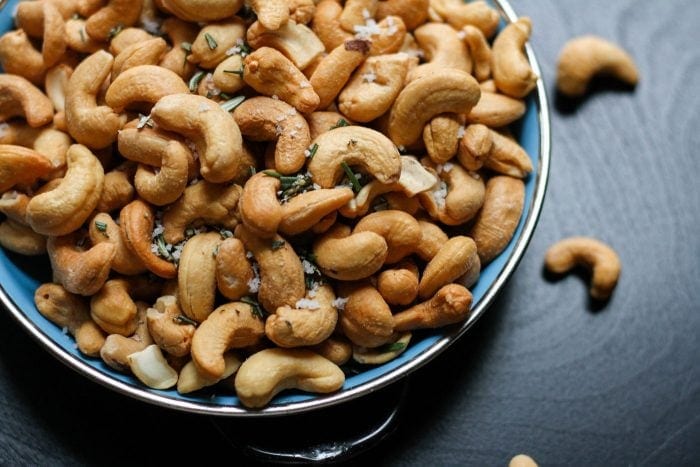
Healthy, whole food fats are an important part of any diet.
Why do we need fat?
- energy and energy storage
- growth, development and cell function – important for recovery!
- nerve function
- cognitive function – a healthy brain!
- healthy skin
- maintaining healthy levels of the hormones testosterone, cortisol, estrogen and progesterone
- transporting fat-soluble vitamins A, D, E and K
Unsaturated vs Saturated Fats
Unsaturated fats that contain omega-3, 6 and 9’s include nuts, seeds, avocado, olives and some oils. Saturated fats include cacao and coconut butter. We need both types of these fats in our diet but the focus should be on unsaturated fats.
Choose whole foods over oils so you can take advantage of the fiber and micronutrients they contain. For more information on types of fats, read my post on an anti-inflammatory diet.
I mostly get fats from nuts, seeds, nut butter, tahini and avocado but I love coconut and cacao too. I don’t really use oils in my diet aside from some MCT oil for bulletproof coffee and coconut oil for desserts, on occasion.
Nuts (Poly-Unsaturated Fats)
- almonds
- brazil nuts
- cashews
- hazelnuts
- macadamia nuts
- pecans
- pine nuts
- pistachios
- walnuts
Seeds (Poly-Unsaturated Fats)
- chia seeds
- flax seeds
- hemp seeds
- pumpkin seeds (pepitas)
- sesame seeds
- raw sunflower seeds
Processed Dairy Alternatives
- almond or cashew yogurt
- coconut yogurt
- vegan cheeses
- vegan sour cream
Nut and Seed Butters (Poly-Unsaturated Fats)
- almond butter
- cashew butter
- macadamia nut butter
- peanut butter
- sunflower seed butter
- tahini
- homemade nut or seed butter
Mono-Unsaturated Fats
- avocado
- olives
Cacao (Saturated Fat)
Enjoy in moderation:
- cacao paste
- cacao nibs
- cacao butter
Coconut (Saturated Fat)
Enjoy in moderation:
- shredded coconut
- flaked coconut
- coconut butter
- coconut cream
- full-fat coconut milk
- plain coconut yogurt
Pure Fat (Oils)
Limit these:
- coconut oil
- MCT oil
- avocado oil
- macadamia nut oil
- sesame oil
- hemp oil
- walnut oil
- extra-virgin olive oil
Protein Sources (Amino Acids)
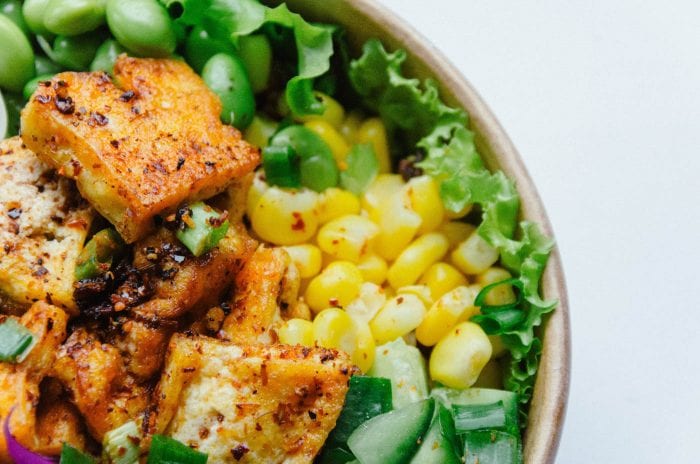
In the plant world, protein is packed up with other macronutrients, so you won’t find the pure protein sources you do in animal foods. Use a variety of the foods listed below to meet your protein requirements but also ensure you’re getting all the essential amino acids you need.
In addition to what are considered to be the best plant protein sources, protein is also found in smaller amounts in the fat and carb sources we’ve already covered so we’ll also take a look at the highest protein veggies, nuts and whole grains.
Getting protein from a wide range of foods ensures you’ll get all the essential amino acids that you need. Essential amino acids are the building blocks of protein and we need to obtain them through the foods we eat.
For more information on protein, amino acids and how much we need, read my guide to vegan protein sources.
My favorite sources of protein are seitan, nutritional yeast, protein powder, tempeh, tofu and lentils.
Mostly All Protein
These foods are high in protein with low amounts of carbs and fats.
- seitan (vital wheat gluten)
- vegan protein powder
- nutritional yeast
- spirulina
- vegan meat alternatives such as Field Roast, Yves and Gardein products
Protein + Carb (High-Fiber, Low-Fat)
These foods contain a moderate amount of protein and carbohydrates and are high in fiber and low in fat.
- beans, any variety (chickpeas, black beans, adzuki beans, mung beans, pinto beans, fava beans, white kidney beans, broad beans, black-eyed peas etc.)
- lentils, any variety (red lentils, green lentils, French lentils, black lentils)
- black bean pasta
- lentil pasta
- edamame pasta
- chickpea pasta
Protein + Fat + Carb
These foods contain a moderate to high amount of protein along with some carbs and fat.
- edamame
- chia seeds
- soy milk
- tofu
- tempeh
- natto
Highest Protein Non-Starchy Vegetables
The amount of protein in these vegetables is considered low but it adds up significantly if you include them in your diet throughout the day.
- green peas
- broccoli
- mushrooms
- kale
- spinach
- artichokes
Highest Protein Whole Grains
To get more protein through the whole grains you’re eating, choose these higher protein options.
- quinoa
- rolled oats
- amaranth
- teff
- wild rice
- buckwheat
- millet
Lowest Carb Nuts for Protein (High-Fat)
These nuts are low in carbs, high in fat and contain some protein.
- macadamia nuts
- pecans
- Brazil nuts
- hazelnuts
- walnuts
Free Foods
Free foods are foods that don’t contain a substantial amount of any macronutrient. Many of them are still rich in vitamins, minerals and antioxidants though.
These foods are great for adding seasoning to your meals without the need for excess salt.
- fresh herbs – cilantro, parsley, basil, dill etc.
- dried herbs
- spices
- mustard
- vinegar
- lemon
- lime
- salsa
- kelp and other seaweeds
Packaged Foods
Below we’ll go over some processed foods that are suitable to include in your diet in moderation.
Packaged Carbohydrate Sources (Low-Fat)
- Veggie Straws
- Rice Cakes
- Rice Crackers
- Ryvita/Wasa Crackers
- Corn Thins
I love having corn thins and rice cakes on hand for snacks. Try using them instead of bread for toppings like avocado or almond butter.
Check out my vegan snacks post for tons of ideas on how to top them! Popcorn is another one of my favourite snacks. It’s high-volume, satisfying and high in fiber.
High-Fat Packaged Foods (Low-Carb)
- Coconut chips
- Flavored nut and seed snacks
- Dark chocolate
- Larabars and other natural food bars
High-Protein Packaged Vegan Foods
- Simply Protein Bars
- Vegan Jerky
- Field Roast Sausage
- Tofurky Sausage
- Sol Veggie Burgers
- Artisan Veggie Burgers
- Dessert Tofu
- Protein Powder
Other Macro-Friendly Packaged Foods
- PB2
- Xyla Ketchup
- Organic Stevia Drops
- Seaweed Snacks
- Applesauce (store-bought or homemade)
- Flatout Bread
More Meal and Snack Ideas
- Macro Friendly Foods for Vegan Flexible Dieting
- 23 Vegan Flexible Dieting Meal and Snack Ideas
- Top Foods for Plant-Based Flexible Dieting
Common Issues
I always go over my carbs.
If you find you’re constantly going way over on carbohydrates, I’d suggest:
- Making swaps. Swap refined, sugary foods for healthy carbohydrates like non-starchy vegetables, sweet potatoes and whole grains
- Eating more soups and salads. Soups and salads are both filling, healthy, high-volume ways to fill up and increase your nutrient intake, without going crazy on carbs.
- Eat more veggies. Increasing your non-starchy vegetable intake by eating more foods like cabbage, broccoli, zucchini, spinach, peppers and cauliflower. Try dishes like spaghetti squash, cauliflower rice or zucchini noodles.
- Adjust your macro ratio. If you eat a plant-based diet, there’s nothing wrong with eating less protein and more fats and carbohydrates so you can focus on meeting your protein needs with whole foods (rather than protein powder, seitan and processed soy products). I’d recommend 40-60% carbohydrates and 20-25% fat with a focus on whole, unrefined carbohydrate sources and whole food fats then filling the rest of your calories from protein sources.
I’m always short on protein.
If you’re always lacking in protein, I’d suggest:
- Adjusting your macros. I eat 20% protein and find that to be plenty to help me recover well and build muscle. The higher the amount of protein, the more difficult it will be to obtain through a whole food plant-based diet.
- Eating protein with every meal. The easiest way to meet your protein requirements is to include a source of protein with every meal and snack. If all your meals and snacks more or less hit the ratio of macronutrients you’re aiming for, it will be easy to get what you need by the end of the day.
- Consider protein powder. I have 1 serving of whole food plant-based protein powder per day to top up my protein needs then easily get the rest through whole foods.
- Get familiar with plant protein sources. Read my post on the best vegan protein sources for a more thorough guide to plant proteins and essential amino acids.
- Enjoy a daily smoothie. Check out my smoothie e-book featuring 66 protein-rich smoothie recipes.
More Ways to Use Protein Powder
- Protein coffee. I love coffee blended with MCT oil and/or vanilla protein powder. Check out my post on vegan bulletproof coffee for more info.
- Protein yogurt. I love mixing vanilla or chocolate protein powder with plain coconut yogurt.
- Proatmeal. I pretty much always add protein to my oatmeal. Try my Carrot Zucchini Pumpkin Oatmeal, Sautéed Apple Cinnamon Oatmeal, Carrot Cake Overnight Protein Oats or Brownie Batter Overnight Protein Oats.
- Squash or pumpkin protein pudding. Vanilla protein powder mixed with acorn, butternut squash or pumpkin puree is delicious and makes a great sweet treat or snack.
- Protein cookie dough. Try my 2-ingredient vegan protein cookie dough made with sweet potato and protein powder.
- Protein Pancakes. Try my 4-Ingredient Fluffy Vegan Protein Pancakes.
What about fiber?
The recommended daily amount of fiber is just 25 grams. I recommend getting over 35 grams per day and if you eat a whole food plant-based diet, you’ll easily achieve that.
Most days, I get somewhere between 50 and 60 grams. If you’re new to a plant-based diet, consider increasing your fiber intake slowly to allow your body and digestive system time to adjust.
If you struggle to get enough fiber in your diet:
- eat a serving of berries daily
- have a coconut yogurt bowl topped with flax and strawberries
- eat raw veggies with hummus for a snack
- eat a serving of nuts every day
- eat kidney beans, chickpeas, lentils and black beans
- eat a daily salad with a variety of vegetables
- include edamame in your diet
- add flax to your oatmeal
- swap all white foods for whole grain ones (pasta, bread, tortillas etc.)
- try amaranth, barley or bulgur instead of rice
Why do we need fiber?
Fiber, in the most basic terms, is the indigestible part of plant foods. Fiber:
- can help lower cholesterol
- helps with weight control or weight loss
- regulates blood sugar
- promotes a healthy heart
- is important for your digestive system.
For more information, read my post on gut health and this post on the best sources of fiber.
What about sugar?
There’s nothing wrong with getting some sugar in your diet from whole food sources such as fruits and whole grains. The sugar in these foods gives us energy and comes along with fiber and other nutrients. If you stick to whole foods, I wouldn’t worry about getting up to 40 grams of sugar every day.
If you find yourself constantly eating much more than that, take a look at where your carbohydrates are coming from. Are you eating a lot of processed foods?
Processed foods often have added sugars to make them taste better and improve their shelf life. These sugars aren’t always listed as “sugar” on the ingredient list. When reading labels, look for to identify added sugar:
- anhydrous dextrose
- brown sugar
- confectioner’s powdered sugar
- corn syrup
- corn syrup solids
- dextrose
- fructose
- high-fructose corn syrup (HFCS)
- honey
- invert sugar
- lactose
- malt syrup
- maltose
- maple syrup
- molasses
- nectars (e.g., peach nectar, pear nectar)
- raw sugar
- sucrose
- cane juice
- evaporated corn sweetener
When in doubt, cut back on processed foods, increase your intake of whole foods and you’ll have no problem with sugar.
I feel my best, have more stable energy levels and fewer cravings when I keep my sugar intake low. For sweetening options to replace processed sugar, check out these natural sugar substitutes.
Vegan Macro Articles
If you are interested in tracking macros from an athletic standpoint, I’d recommend reading the following articles to get you familiar with the how and the why of macros:
Flexible Dieting FAQ // How to Get Started with Flexible Dieting // Vegan Flexible Dieting Meal Plans // Vegan IIFYM: Tips and Meal Plans // Nutrition Tips for Vegan Athletes
More Reading
Vegan Nutrition Guide // Vegan Grocery List // Best Vegan Protein Sources // 3-Day Whole Food Plant-Based Meal Plan // How to Transition to a Plant-Based Diet

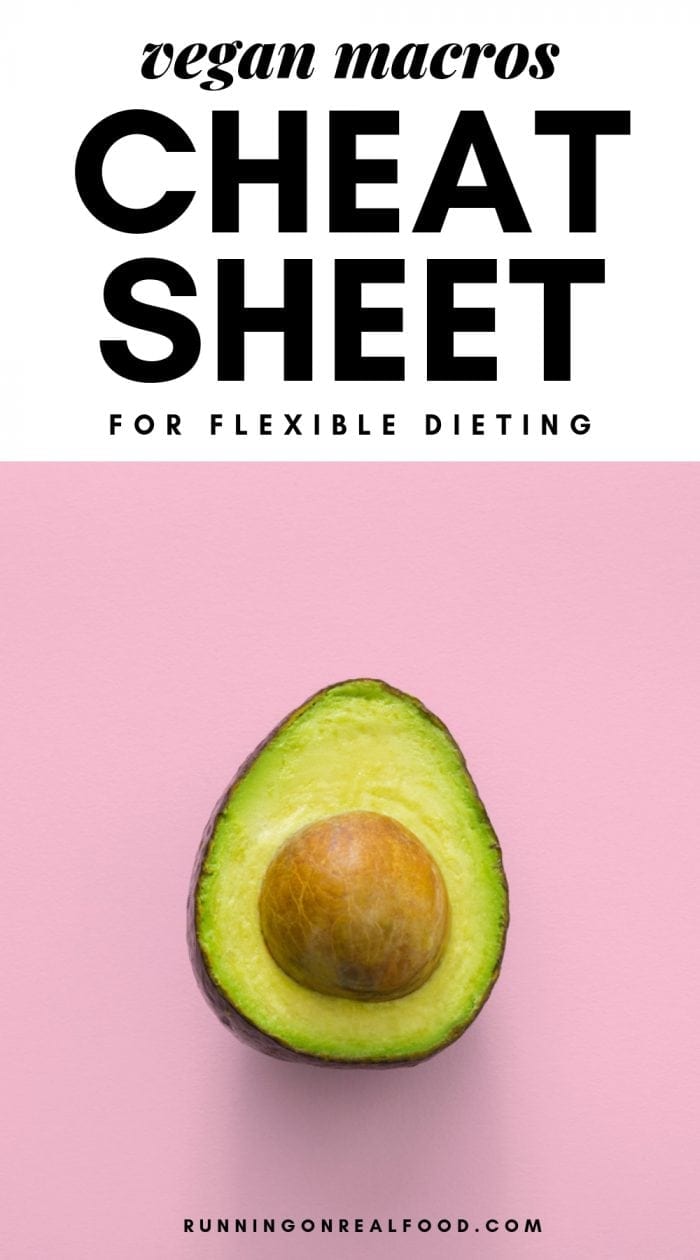

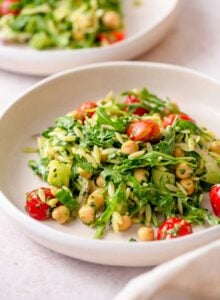
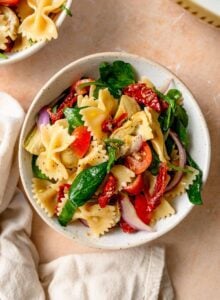
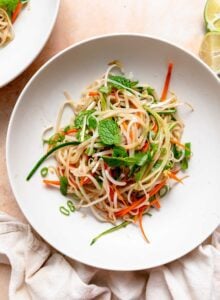
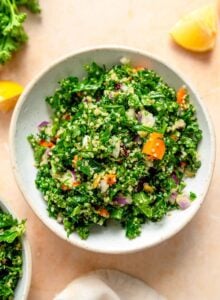
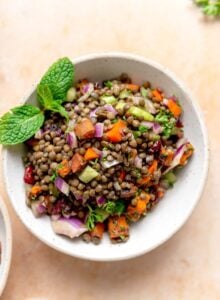
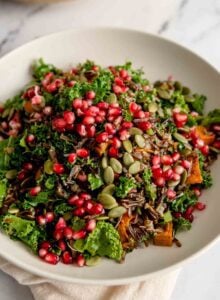
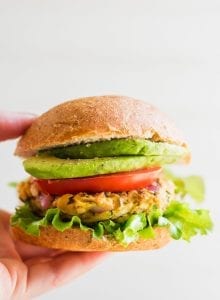
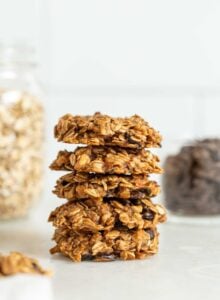
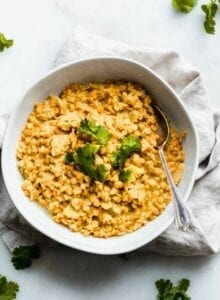
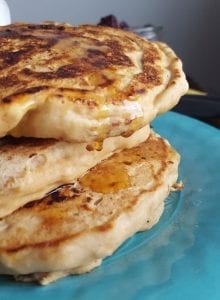
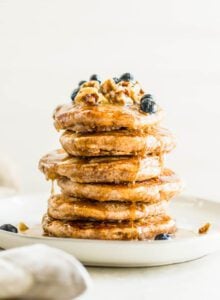

Hi,
I’ve been vegan for five years but I want to focus now on losing weight and choosing healthier options. I am starting to fast so just two meals a day at 3 and 7. Do you have meal plans for purchase?
I don’t, I’m sorry. Good luck!
Hi and thank you for this extensive article. I want to lose weight and build muscle. I am vegan. Is there any chance you have recipes already available for us to get started? I work out every day – indoor biking, Norditrack, lift weights. I still cannot lose the weight nor gain muscle. I also have a Farm Sanctuary rescuing farmed animals so I am busy cleaning, feeding etc Def not a couch potato lol.
I am currently on WW. While I don’t need to lose more than 8 pounds to feel good and look good I do want to build muscle as well.
Thank you!
I have hundreds of recipes that include the macros. If you go up to the top and click recipes, you’ll be able to check them out. Thanks!
What a great resource! Amazing work Deryn! Thanks for putting this together, it is so helpful for vegans looking to enjoy balanced plant based meals for fat loss, maintenance, or muscle gain. Peace and Love.
I have had tofu twice and it was yucky at high end restaurants. Any suggestions for how I can give it another try. I am almost completely vegan and I want to continue to build muscle but all plans I see have tofu and seitan listed. In your opinion s it possible to stay away from those products and still grow muscles. I competed in a figure contest in 2019 before I stopped eating meat. I would like to compete again, but know I need to increase my protein.
Thanks for you thoughts.
Your recipes look so amazing. I am so glad I came across you today!!!
Cynthia
You can but you’ll need to focus on other protein sources like protein powder, hemp seeds, beans and lentils. You don’t need to eat super high protein but getting enough is important along with enough overall calories, and of course, training hard! I have many tofu recipes you can try but if you don’t like it you could try tempeh or edamame, both are great sources of protein too. You can use the search box at the top of the site to browse some tempeh recipes…or tofu if you want to try it at home.
Great list, will definitely be using your guide! And as a side note, I must know!
I would love to try it–What is the recipe for the last photo? The one with the corn, greens and it looks like a seasoned tofu? Thank you!
Thanks so much for the extensive info on vegan macro eating. These posts are invaluable and are helping me immensely!
You’re so welcome! Have fun and enjoy the process!
I have really found your articles full of great and helpful information. I have been vegan for just about 2 years one of the best decisions I ever made. The last couple of months I haven’t been feeling as good as I was tired, just can’t lose weight, stuff like that and after reading this I feel this will help me get back to being a much better eater. I have been printing out your free printable sheets, going from one article to the next. Thank you for all your great information. So glad I found this.
Theresa
I’m so glad you’re finding everything helpful!! I’m glad you found it too. Thanks for the message. Enjoy!
Oh my goodness this is so lovely, i just spent an hour reading through all of this and I feel so enlightened now haha! Is there anyway you can make a PDF of this? Like maybe of each food group and the lists of what specific foods are best, all the writing and explaining part can be read here so no need to include all of that or else that would be quite a large and long PDF haha! Thanks so much for this as well as what you do in general, i am a 19 year old from Chicago currently recovering from an eating disorder and to be able to sit through an entire article/blog post about food and nutrients and what not is VERY hard and i usually get angry and irritated after reading anything to do with fixing eating habits etc, but i genuinely read this without anorexia’s voice getting in the way and very much so enjoyed it. Sorry this is probably so obnoxious I just want you to know what you’re doing is much appreciated. XOXO have a beautiful rest of your day.
Hi Riley 🙂 It’s not obnoxious at all, I appreciate hearing from you!! I plan to create a PDF of the info soon! I’ll let you know when I do. I’m so glad you found this helpful. Please let me know if there’s anything else I can help with. I love writing these kinds of articles.
Thank you so much for compiling this list! I am a newer vegan and have been having difficulty lately feeling full while exercising. This has really broken down the different types of nutrients and I feel less reliant on processed food and white carbs! The vegetable and fruit high vs low piece was also very helpful, I knew about sugar contents in fruits but wouldn’t of known about the volume aspect without this article!
I’m so glad you found this helpful!! For me, preparing food at home and doing some meal prep is essential. So easy to eat well when you’ve got healthy options ready to go!